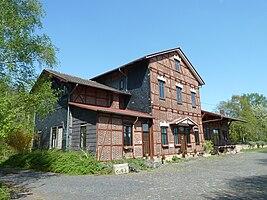Schwebda railway station
| Schwebda | |
|---|---|
|
Street side of the former station building
|
|
| Data | |
| Location in the network | Separation station |
| abbreviation | FSWB / FSWH |
| opening | May 5, 1880 |
| location | |
| City / municipality | Meinhard |
| Place / district | Schwebda |
| country | Hesse |
| Country | Germany |
| Coordinates | 51 ° 12 '20 " N , 10 ° 5' 37" E |
| Railway lines | |
| Railway stations in Hessen | |
The Schwebda station was a junction station in Schwebda (now part of the community Meinhard ) at the leinefelde-treysa railway (part of the Cannons Railway ).
history
The station was opened together with the Leinefelde – Treysa railway line (here: km 41.27), part of the “Kanonenbahn”, on May 5, 1880. The Schwebda – Wartha railway branched off here since 1902 , and the Heiligenstadt – Schwebda railway since 1914 .
In 1945 the routes to Wartha and Heiligenstadt were interrupted by the inner-German border . In 1980 the existing passenger traffic to Wanfried was discontinued and Schwebda was no longer served by passenger trains. In 1996, freight traffic on the route also ended.
Infrastructure
In 1902, Schwebda station became a branch station when the line leading to Wartha was threaded through the eastern entrance to the station. The line to Heiligenstadt, on the other hand, also ran in an easterly direction, on its own track, but parallel to the Kanonenbahn through the Friedatunnel and a further three kilometers before it followed its own route shortly before the Großtöpfer train station .
The reception building of the station was completed 1881st It lies north of the tracks and is a late classicist type building ( half-timbered structure ) filled with brick . The building is a cultural monument due to the Hessian Monument Protection Act .
literature
- Reinhold Salzmann: The cannon railway - history and fate of a large railway project. In: Rund um den Alheimer 34 (2013), pp. 6–23 (7)
- Heinz Schomann : Railway in Hessen. Cultural monuments in Hessen. Monument topography Federal Republic of Germany . Ed .: State Office for Monument Preservation Hessen . Theiss publishing house. Stuttgart, 2005. Vol. 2.2. ISBN 3-8062-1917-6
- Railway Atlas Germany . 9th edition. Schweers + Wall, Aachen 2014, ISBN 978-3-89494-145-1 .
Web links
- Wellness and Ayurveda in the historic train station
- Hermann Josef Friske: Kanonenbahn , in it: History of the Schwebda station

